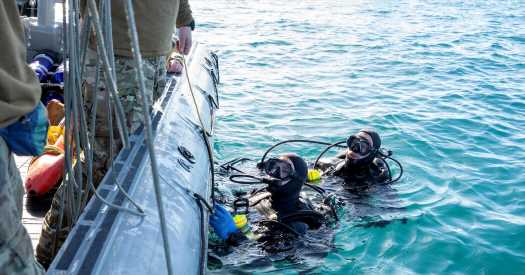Navy Divers Complete Recovery of Chinese Spy Balloon Debris
WASHINGTON — Navy divers on Thursday completed an operation to recover pieces of the Chinese spy balloon that a U.S. fighter jet had shot down off the coast of South Carolina this month, according to U.S. Northern Command.
The recovered debris was sent to the Federal Bureau of Investigation’s laboratory in Quantico, Va., for further analysis, including “counterintelligence exploitation,” raising the possibility of greater visibility into what the balloon had been able to capture as it traversed parts of the United States.
In remarks on Thursday, President Biden called the spy balloon a “violation of our sovereignty” and said the analysis of the salvaged material could provide insights into China’s spying capabilities. But he insisted he would speak to President Xi Jinping of China, in an apparent effort to calm tensions over the incident.
“Our experts lifted components of the Chinese balloon’s payload off the ocean’s floor,” Mr. Biden said. “We’re analyzing them as I speak and what we learn will strengthen our capabilities.”
“We’re not looking for a new Cold War,” he added.
A spokesman for the U.S. Northern Command declined to comment on what was recovered or how long a full analysis could take.
A U.S. F-22 hit the balloon with a Sidewinder missile at an altitude between 60,000 and 65,000 feet, according to the Pentagon, and dive teams began bringing debris back days later.
But the completion of the recovery nonetheless raised questions about what intelligence could be gleaned from the remains, as occurred in 1960 when the Soviet Union pored over the wreckage of a U-2 plane or in 2001 when the Chinese military looked over a damaged Navy spy plane involved in a collision with a Chinese jet.
The decision to wait until the balloon had reached the ocean was described by the White House and senior military advisers as a precaution, to avoid bringing it down in an area that might pose a risk to civilians. And the choice of an air-to-air missile was framed as a practical consideration, given the failure by Canadian fighter planes in 1998 to down a rogue weather balloon after firing over 1,000 20-millimeter rounds at it.
The widely anticipated downing of the balloon drew spectators to South Carolina, where crowds formed to watch the event. But the operation required the Federal Aviation Administration to briefly block air traffic over the coast, and parts of the region were closed off as the recovery effort was carried out.
According to the announcement by Northern Command, as of Thursday, U.S. Navy and Coast Guard vessels had departed the area and air and maritime safety perimeters had been lifted.
Source: Read Full Article

